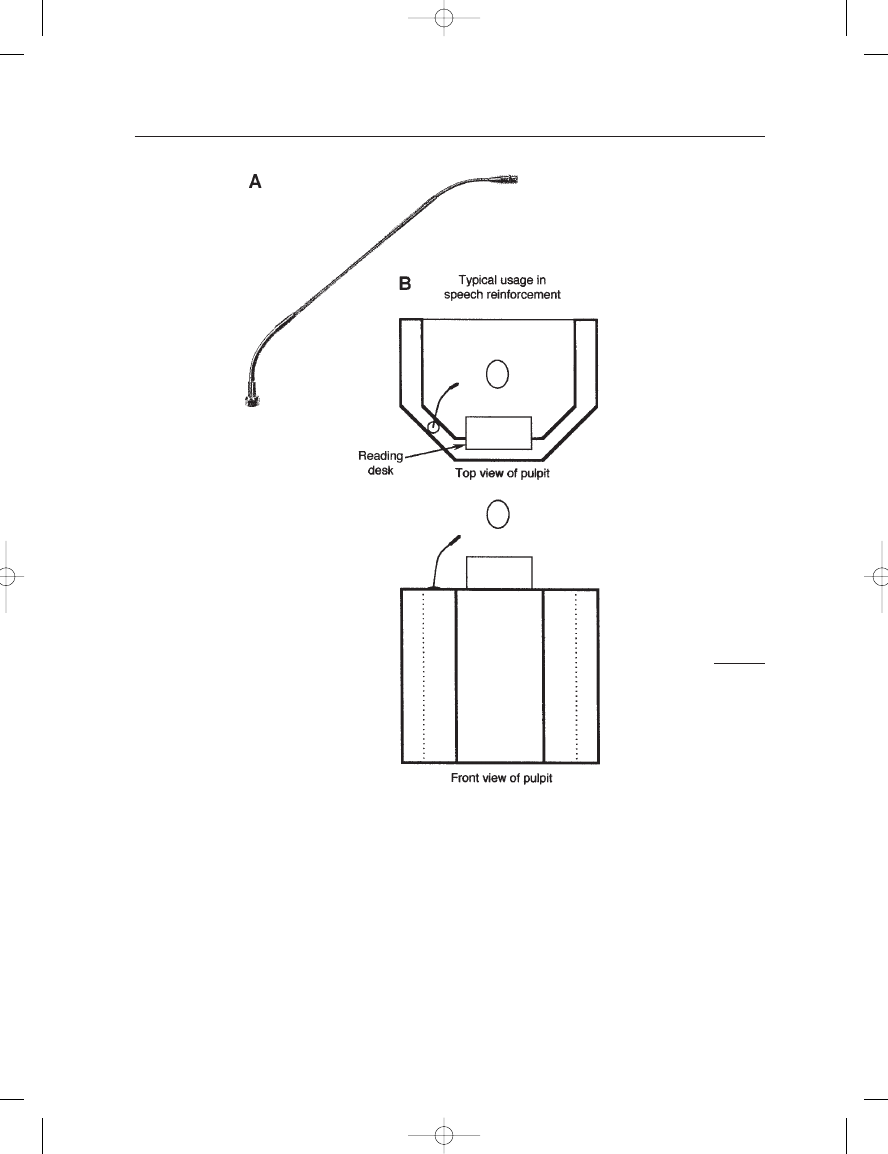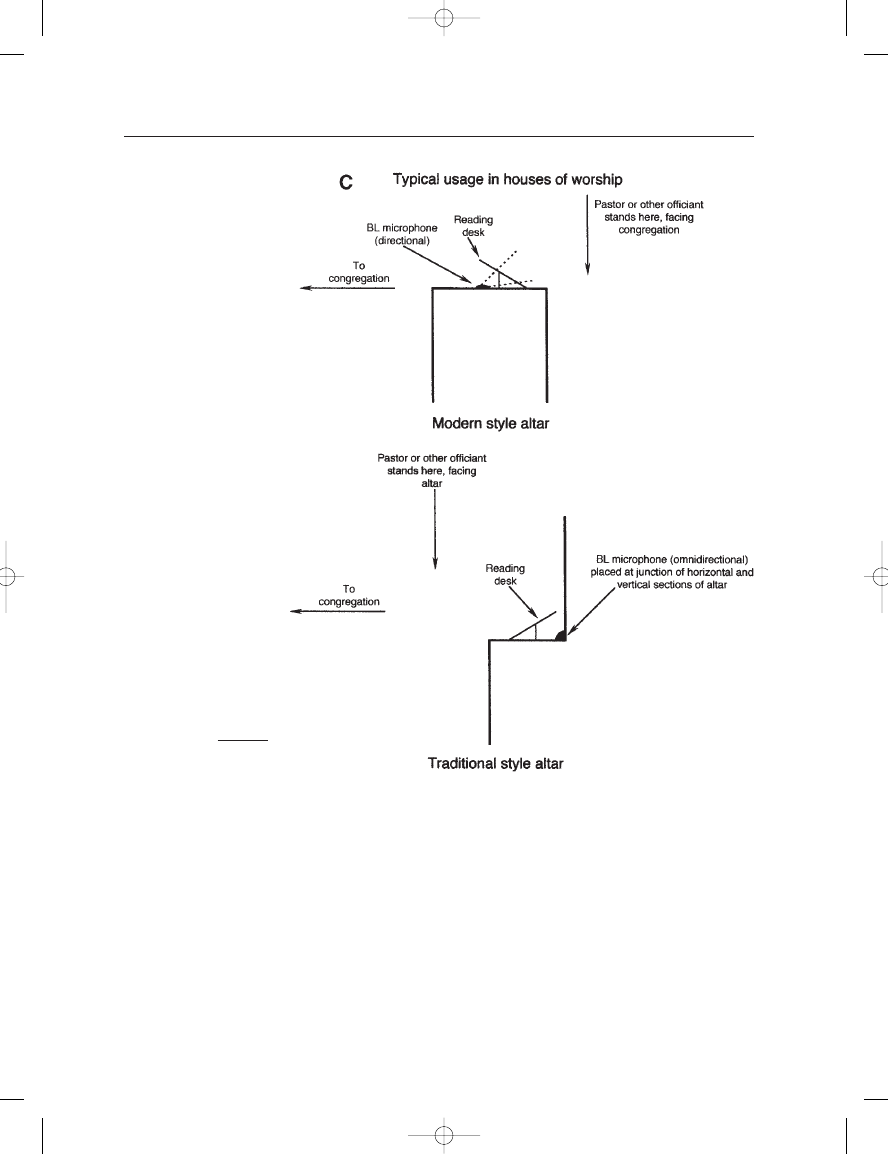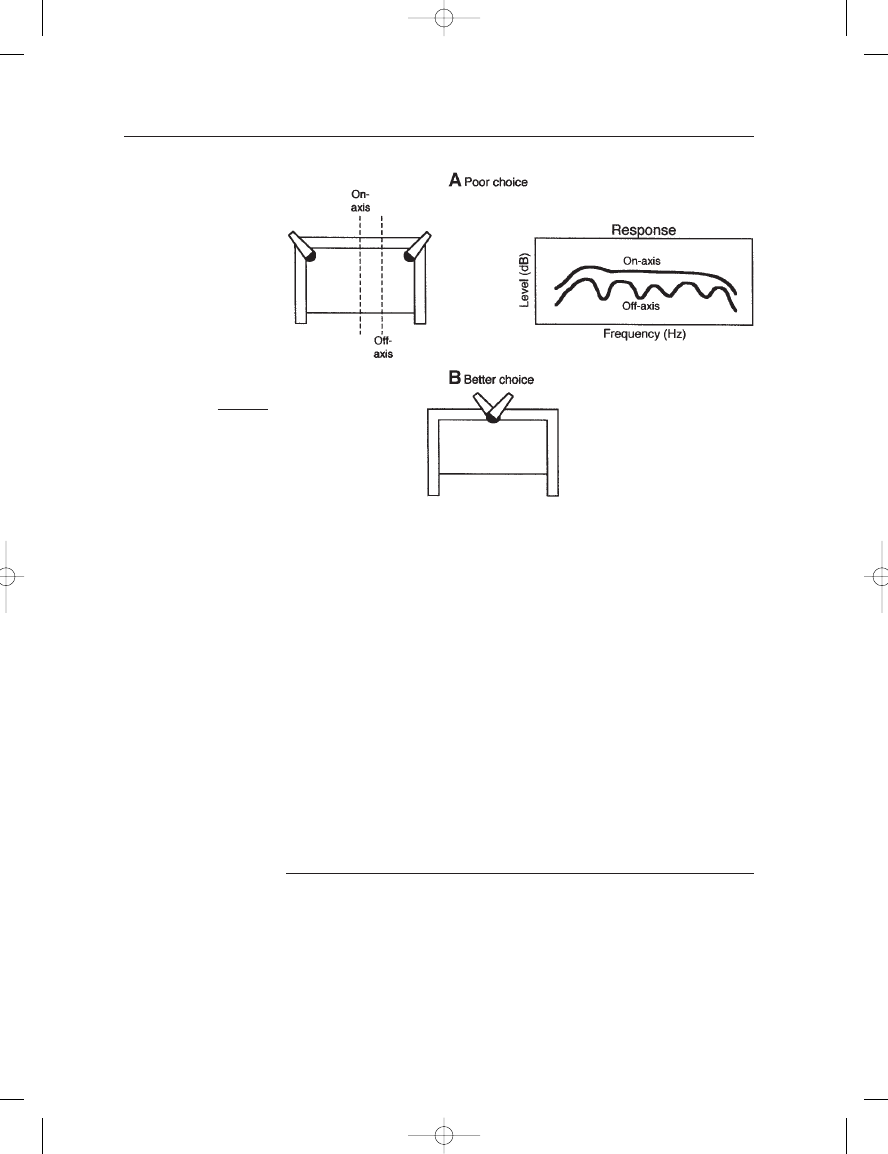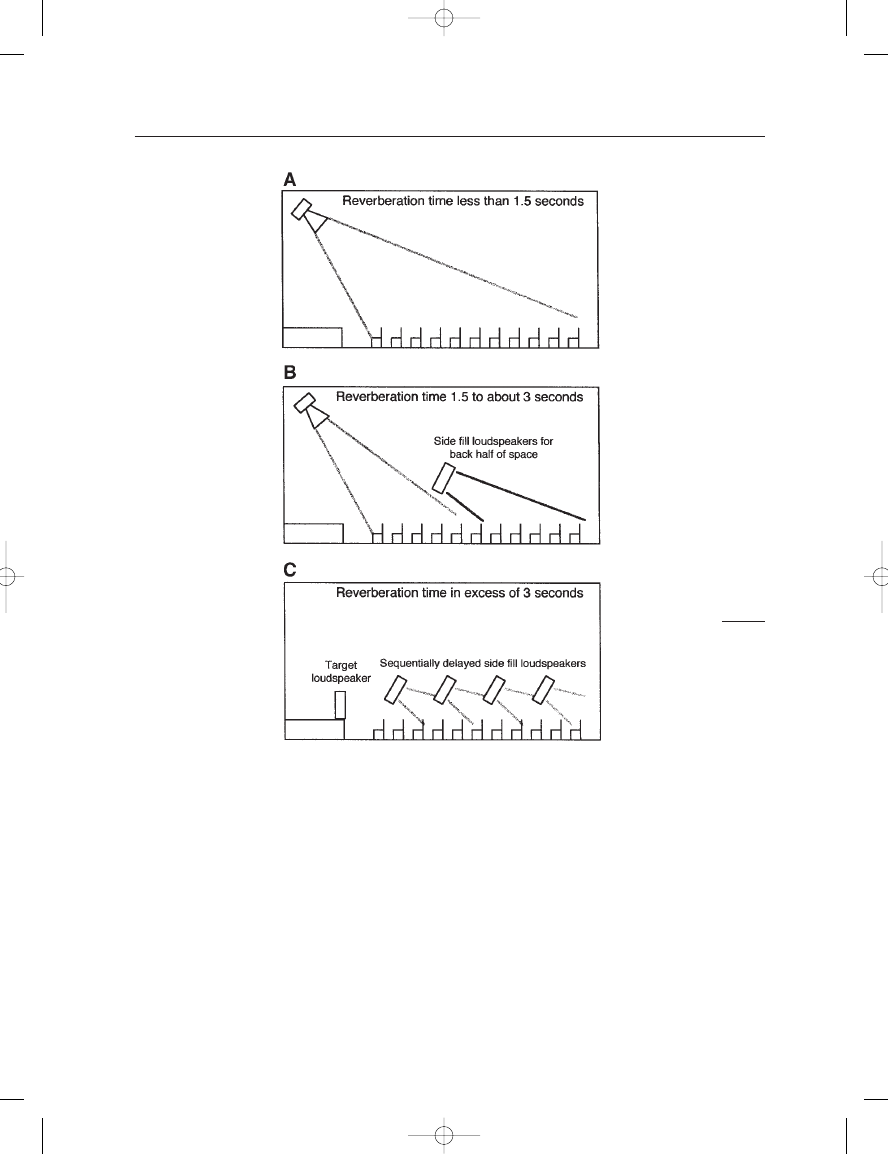ВУЗ: Казахская Национальная Академия Искусств им. Т. Жургенова
Категория: Книга
Дисциплина: Не указана
Добавлен: 03.02.2019
Просмотров: 17256
Скачиваний: 51

hold it slightly to the side, outside the breath stream, and maintain
a consistent operating distance.
The head-worn microphone (shown at B) has long been a staple in
communications activities, but it was not until its adoption by singer
Garth Brooks that it became a staple for on-stage performance. The micro-
phone element is an electret, normally with a cardioid or hypercardioid
pattern, and equalized for close use. When properly worn it is stable in its
positioning and offers excellent performance. It is invariably used with
wireless bodypacks, and for lecturers or panelists it provides complete
freedom of movement. Caution: it must be properly fitted and not be
allowed to slip into position in the breath stream of the talker or singer.
THE MICROPHONE BOOK
308
FIGURE 18–7
Microphones for speech
reinforcement: podium
microphone (A); podium
usage (B); boundary layer
usage on an altar (C).
(Photo courtesy of Crown
International.)
Earg_18.qxd 14/9/04 3:01 PM Page 308

For permanent podium or lectern mounting there are numerous
miniature electret cardioid or hypercardioid models mounted on flexible
gooseneck extensions, as shown at Figure 18–7A and B. These can be
unobtrusively located to one side and positioned at a distance of
30–50 cm (12–20 in) from the mouth of the talker. A small windscreen
is recommended. It is important that the gooseneck portion be out of the
range of movement of papers or notes used by the talker and that the
talker’s normal motions not be impeded.
For use on flat surfaces, such as tables used in panel discussions, or
altars in houses of worship, a boundary layer microphone (shown at C)
is essential. An omni pattern often works best, but cardioid models may
be necessary to minimize local noises. The cardioid, however, will be
18: Fundamentals of Speech and Music Reinforcement
309
FIGURE 18–7
Continued.
Earg_18.qxd 14/9/04 3:01 PM Page 309

more subject to impact noises than the omni. The operating distance is
normally in the range of 45–60 cm (18–24 in).
The tie-tack microphone, which was introduced in the previous
chapter, has the advantages of a small electret and is very popular
primarily because it is inconspicuous. It is important that it be fastened
to the user’s lapel or tie with enough slack in the cable to avoid pulling
or tugging on the cable as the performer moves around. For sedentary
applications the microphone may be wired directly, but for most
purposes it is used with a wireless bodypack. Position the microphone as
high as possible on the tie or lapel; however, be aware that in a high posi-
tion normal up and down head movements may cause audible shifts in
level. Make the right compromise. The tie-tack microphone’s response is
normally shaped as shown to minimize radiation from the chest cavity
and to maintain HF response.
TWO COMMON PROBLEMS
When microphones are positioned close to reflecting surfaces, the
delayed reflection may combine with the direct sound, producing some
degree of comb filtering in response. Figure 18–8A shows an omni
THE MICROPHONE BOOK
310
FIGURE 18–8
Delayed reflections; an
omni microphone in the
path of a reflection (A); a
hypercardioid microphone
with the reflection reduced
by the off-axis attenuation
of the pickup pattern (B).
Earg_18.qxd 14/9/04 3:01 PM Page 310

microphone mounted on a podium in such a way that it will pick up
a distinct reflection from the reading desk, producing uneven response.
Moving the microphone to one side will alleviate this problem to some
degree. A better solution is to use a hypercardioid microphone, whose
off-axis response will attenuate the reflection, as shown at B.
Another common problem is the use of two microphones where one
is sufficient. Improper usage is shown in Figure 18–9A. In broadcasting
of important events, doubling of microphones is often done for trans-
mission redundancy in case of failure of one channel, but more often
than not both microphones end up operating in parallel. For a talker
directly between the two there may be no problem. But talkers do move
around, and the combined signals from both microphones will cause
peaks and dips in response as shown. The solution is shown at B, where
both microphones are mounted in coincident fashion and splayed
slightly to increase the effective pickup angle. In this case the position of
the talker will not be a problem since the talker’s distance to the two
microphones remains the same.
LOUDSPEAKER ARRAY OPTIONS IN LARGE SPACES
The basic loudspeaker approach for a venue depends on many things,
but the reverberation time is paramount. Consider the space shown in
Figure 18–10.
If the reverberation time is less than about 1.5 s, a single central
loudspeaker array is usually the best solution. It has the advantage of
single point radiation and will sound quite natural to all patrons. It must
of course be designed so that it covers the audience seating area smoothly
18: Fundamentals of Speech and Music Reinforcement
311
FIGURE 18–9
Cancellations due to
multiple microphones;
improper implementation
(A); proper
implementation (B).
Earg_18.qxd 14/9/04 3:01 PM Page 311

and minimizes sound projected onto the walls. The design approach is
shown at A.
If the same space has a reverberation time between about 1.5 and
3 s, then it may be more effective to supplement the central array with
additional side wall arrays at about halfway the length of the space. The
primary array is then adjusted so that it covers the front of the space, and
the secondary arrays are delayed so that the progressive wavefronts from
the main and secondary arrays will be effectively “in-step” at the back
of the space. The primary aim is to increase the D/R ratio in the back half
of the space. The design approach is shown at B.
Finally, if the same space has a reverberation time exceeding about
3 s, a conventional distributed system may be required. Here, there is no
central array as such, but rather a series of smaller loudspeakers located
THE MICROPHONE BOOK
312
FIGURE 18–10
Speech reinforcement
in large spaces: low
reverberation time
(A); moderate
reverberation time (B);
high reverberation
time (C).
Earg_18.qxd 14/9/04 3:01 PM Page 312